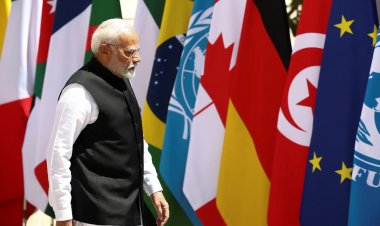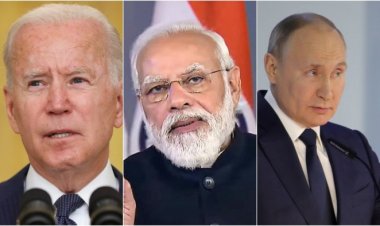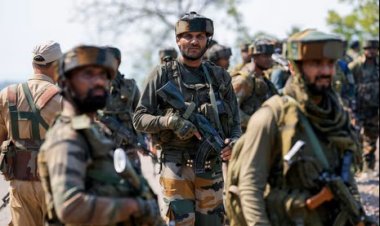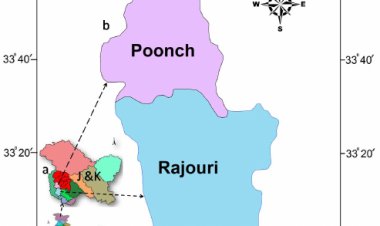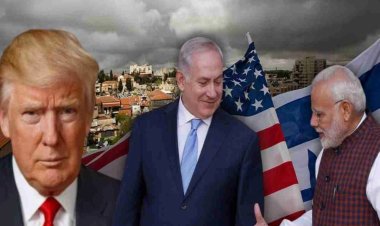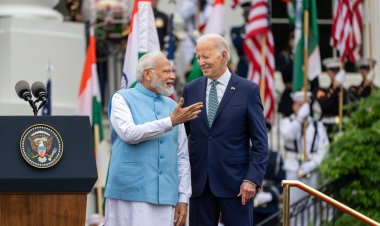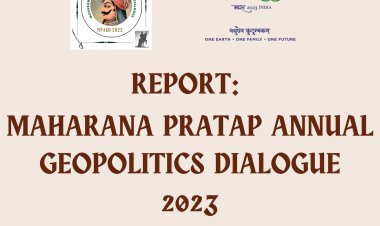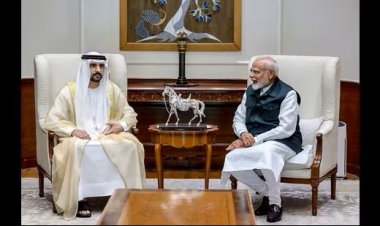India Needs Deep Adjustments
India is taking a central role in the World. India is a coming superpower. Forget the “G7”. India’s successful population of 1.3 billion has nuclear weapons and a fast-growing economy already bigger than the surpassing the UK – in a few decades even surpassing the USA. India has enormous potential and is making fast progress. This is, however, hampered by India's state of war on no less than two huge fronts with no less than two nuclear-armed and allied partners. India can only lose through ongoing conflict. China's economy is five times bigger than India's, and over the next decade, China will even widen that gap to an advantage factor of six over India. See Fig. 1. These economic fundamentals decisively restrict the options available for India in Grand Strategy.
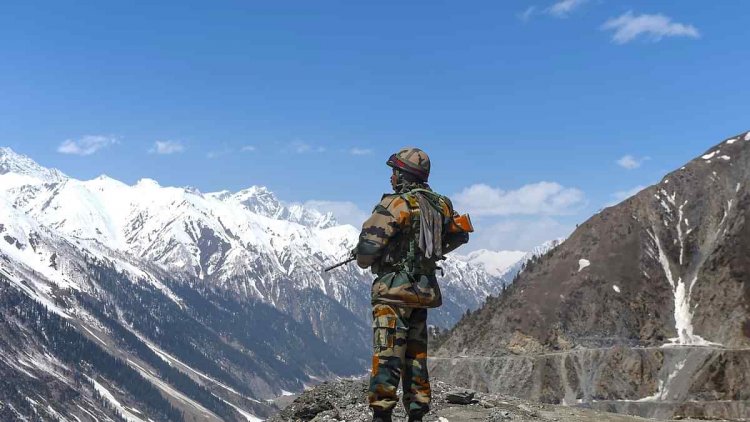
Analysis
By - Karsten Riise
Superpower with a dilemma
India is taking a central role in the World. India is a coming superpower. Forget the “G7”. India’s successful population of 1.3 billion has nuclear weapons and a fast-growing economy already bigger than the surpassing the UK – in a few decades even surpassing the USA. India has enormous potential and is making fast progress. This is, however, hampered by India's state of war on no less than two huge fronts with no less than two nuclear-armed and allied partners. India can only lose through ongoing conflict. China's economy is 5 times bigger than India's, and over the next decade, China will even widen that gap to an advantage factor of 6 over India. See Fig. 1. These economic fundamentals decisively restrict the options available for India in Grand Strategy.

Fig. 1: Share of World GDP – 2021-26 IMF projections, 2027-40 extrapolations.
Losing military tech-race with China
India is losing the race in expensive high-tech weapons to China. Compare India’s Tejas Mk2 fighter with China's J-20. The data look similar, until you notice things like J-20’s advanced AESA radar, nearstealth radar-visibility, and new indigenous engine. Plus the fact, that China not only has the J-20, but has whole strong pipeline with the J-31, advanced fighter missiles, a new GJ-11 stealth drone and much more. Compare India's navy development (incl. carriers) with China's ditto - and you see it even more clearly. Even worse - on the Himalayan front, which depends on foot-soldiers, China may several years before India implement crucial tech enhancements coming for foot-soldiers.
China is simply unsurpassed in adapting technologies, and these technologies fit directly into China’s strengths in super-fast industrial and electronic innovation. Chinese soldiers will be able to pick out Indian soldiers at 1,300 m distance – also at night - without Indian soldiers being able to even see their Chinese counterparts. Digital integration and networking of hand-weapons and personal equipment will make each Chinese soldier see individual Indian soldiers on helmet-mounted binoculars, and beamed into their vision headset wirelessly from infrared cameras on aircraft above. 24/7. Day and night. Year round. Even in snowy weather. This is already US technology today. China is betting on intelligentized (智能化) war concepts. China will also create intelligentized infantry concepts surpassing the USA. Shenzhen is ready to mass-produce it at low-cost high-quality to supply every man in all China's mountain divisions.
Anyone can go into the details, as they want to, and will very probably confirm that the overall picture I describe here is correct.
Buying or making?
China has reached the point, where China herself produces everything in World class leading weapons systems. Years ago, China used to buy combat aircraft (the Flanker) from Russia. Now China makes even the most advanced all military aircraft and space craft herself. For some years, China still imported jet engines from Russia for Chinese aircraft. Now China even produces the engines. Only thing China newly imported was the Russian S-400 anti-aircraft system. Soon, China will make that too. China also produces own nuclear submarines, missile destroyers, and aircraft carriers, where the next Type 004 will be nuclear and similar in size and pace of sortie-generation to the newest US carriers. In hypersonic missiles, China (like Russia) is superior to the USA.
Only three countries in the World make the whole range of all the most sophisticated weapons: China, USA, and Russia. Countries like France (including their Raffaele jets and submarines) is falling far behind, and little Sweden will probably never make its own combat aircraft after the JAS. UK is on par with France. Germany is doing a little better, opting to increase volume and quality in military aircraft through international partnerships with EU-partners like Spain and Italy (Airbus). France should long ago have fully embraced the German path. India with an economy now bigger than the UK, is in own military production today in class with France – and that is not good.
The good news are that India has the potential to enter the class of China and the USA in making her own World class weapons in every category. The bad news is that this strategic transition in India’s military industry will take 10-15 years, and China is not only already fully there, China is currently creating a global lead at a staggering pace.
Why a World class domestic military industry is crucial for India, is visible on Fig. 2: Domestic Purchase Power.

Fig. 2 – Share of global Purchase Power – 2021-26 IMF projections, 2027-40 extrapolations.
The crucial point is, that when a country buys weapons from others, it is paid in dollars, where Figure
1 – GDP in US dollars - apply. In GDP measured as US dollars, the US is still number 1, though only 13% above China. This is only due to the (artificially?) low exchange rate of the Yuan. At a more proper exchange rate, China is probably already the biggest economy in the World, also in GDP. Be this as it may, because China makes all her own advanced weapons, China does not have to buy anything but the steel for ships in dollars – the rest, design, engineering, and manufacturing of all weapons is paid by China’s government at the still low wages in China. Therefore, in the military purchase, China’s Purchase Power Parity (PPP) relative to the USA is the right measure, ref. Fig.2. And Fig.2 demonstrates, that China already in 2016 surpassed the US in Purchase Power – and only five years later, today 2021, China already has a significant lead of 15% over the USA in PPP, that is in economic strength to develop and acquire enormous quantities of the World’s most sophisticated weapons. In other words: China is today a far stronger military-industrial power than the USA.
Russia also produces all her own advanced weapons. Therefore Fig.2 also applies to Russia. And we see that Russia in PPP is nearly on par with Germany. The UK and France are not even on the list of the G8, the World’s eight biggest economies measured in PPP.
India buys Raffaele jets from France. India imports naval ships. And so on. In importing all these über expensive military gizmos, India has to pay dollars – that is, India more modest curve in GDP ref. Fig.1, applies. To fully play out on India’s own domestic strengths, including competitive wages for world-class engineers, India must produce basically all military equipment herself. Thereby, India can transition to the strong India economic curve of Purchase Power Parity (PPP) in Fig.2, where India is on track to surpass the US economy in 2040.
India already successfully has her own space program. India successfully also has her own nuclear technologies and a lot of other advanced things. India also makes her own combat vehicles, though perhaps not just as successfully. India needs to take the full step – and be sure to be top-of-class in the World. The path to achieving this is to do what China has done, only better of course: Buy components, technologies, and designs from other countries, and make the stuff at home. Then gradually transition to make more and more stuff at home, until everything is mastered. Doing so, India must keep the kind of partnership that India has always had with Russia – open and confident. India will eventually become stronger than Russia, but that will take some time, and strategically, Russia will benefit. For instance, Russia has a weakness in avionics. Avionics is one of the areas, where the USA is leading over Russia. India can make win-win cooperation with Russia, sharing Russia’s developments in aircraft like the Su-57 – and in return developing avionics and computers beyond what the US has.
These are things which India must do very fast. But we speak of strategic military-industrial structures, where “fast” results come in 5-10 years.
India's needs to stop the strength-drain
India needs strategic change which can have an effect now.
China is drawing enormous numbers of Indian soldiers away from India’s Pakistani front over to India’s Chinese fronts (3 segments). With all this new hi-tech soldier equipment soon coming as a tsunami in China - integrated digital vision day/night,automatic targeting rifles, wifi images with GPS and voice-over to every soldier - India will need ever more soldiers (and money!!) to confront China. Once China has all this military stuff mass-produced, China will give it to Pakistan (paid by a small loan) - demanding even more Indian infantry to return to the Pakistani front. Backing this up comes enormous Chinese investments in mountain-supply-roads and armored vehicles, artillery, and rocket launchers. In the air, J-20 Chinese jets may threaten to establish air superiority over India’s new Tejas Mk2 jets. On the ocean, India is struggling to keep pace with China too. Any time, within the next 2-3 years, India can be drawn pale by needs for military manpower confronting both China and Pakistan.
India is falling behind China and can never win anything from having two never-ending conflicts with China and Pakistan, which have been going on for 74 years, since India was created in 1947. Military costs in manpower and money are draining India’s development while China can speed up. India needs to stop this, and find a solution with Pakistan and China.
China is holding back
There are two reasons, why India has not been squeezed by China - and both are due to China, not India. According to traditional wisdom, China is aggressive on the India-China border. I want to challenge that. Considering what China is capable of relative to India, China is actually holding back.
First of all, China's attention is of course on Taiwan, air/naval control out to the 1st Island Chain, and competition with the USA. Second, if China really had had aggressive intentions with India, China’s would have given this a lot harder military priority, and India’s situation would have been awful by now. There is a border dispute, the nature of which is centered on a nearly uninhabited area Aksai Chin which India probably never has effectively controlled. The effect today I eruptions on the Lineof-Actual-Control, some of which are not always initiated by China. Russia has solved all border disputes with China and has built a close and productive relationship with China. India should be able to do the same. India’s pretentions for Aksai Chin and northern Pakistan have been illusionary all the time for three-quarters of a century. India must finally wake-up to reality.
For India, this implies deep strategic political-military-cultural/religious/national-economic changes.
Bright options for India
India can change this. A bad future with China and Pakistan does not have to happen for India. On the contrary - India can have a bright future. New paradigms are needed, however. National border and self-perception paradigms. Religious/Cultural/Nationalism paradigms including Hindu/Muslim relations. Economic development & trade paradigms. And military paradigms - including possibly a new aircraft cooperation with Russia and an expanded role for India's Air Force both over Sea and Land. I see India as part of an Afro-Eurasian Continent (Mackinder) encompassing all the area from Ireland to South Africa to Russia, China, Japan, and Malaysia. India-Pakistan is a potential partnership with enormous resources to set free – India just has to develop the status quo. I also see India in this partnership within a Region of Collaboration around the Indian Ocean - with Africa as a huge potential.
These are profound changes - India has only catastrophic alternatives from continued conflict, whereas the results of deep changes can be extraordinary for India. The above are of course controversial talking-points - but important.
Reality is not always appreciated before facts pile up high – and India is perhaps no exception to this.
Here in 2021, India lost its ally in Kabul to Pakistan, but that has not yet fundamentally changed India’s stance. A US defeat on China (Taiwan) can make India make fundamentally different calculations than what they do today.
Karsten Riise is a Master of Science (Econ) from Copenhagen Business School and has a university degree in Spanish Culture and Languages from Copenhagen University. He is the former Senior Vice President Chief Financial Officer (CFO) of Mercedes-Benz in Denmark and Sweden. At the time of appointment, he was the youngest and the first non-German in that top position within Mercedes-Benz’ worldwide sales organization. He writes regularly for the Russian International Affairs Council.
Disclaimer: This paper is the author’s individual scholastic contribution and does not necessarily reflect the organisation’s viewpoint.

